This is the last part of my GDC trilogy about the gamer’s brain (how cool is that!). A warm thanks to all of you who liked my previous talks, gave me constructive feedback, and supported me! 🙂
This post is a transcript of my talk with the slides. You can find transcripts of the first two parts of my Gamer’s Brain talks here and here. If you’re interested, you can also check my book. Thank you!
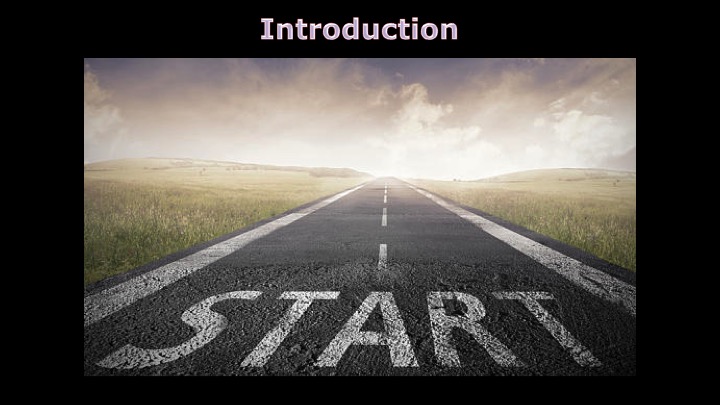
Quick explanation of cognitive psychology principles and UX that I discussed in my previous talks, just to have everyone on the same page.
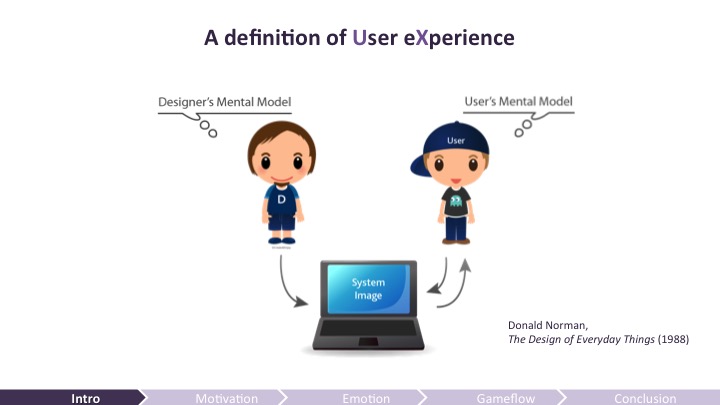
User experience is all about making sure that your user (player) is going to experience the game the way you, as a developer, intended.
You want the system image (the game) to convey truthfully the experience you want to offer.
To do that, we explore how a player perceives and interacts with a game and the satisfaction and emotions elicited via this interaction. UX takes its roots in cognitive science, human factors, and human-computer interaction.

UX principles rely on cognitive science knowledge. This is why you need to understand how the brain processes information.
Today we’re going to look into motivation more specifically. Motivation is one of the variables influencing info processing.
Disclaimer! This is highly simplified! Making games is very complex, so is the brain.
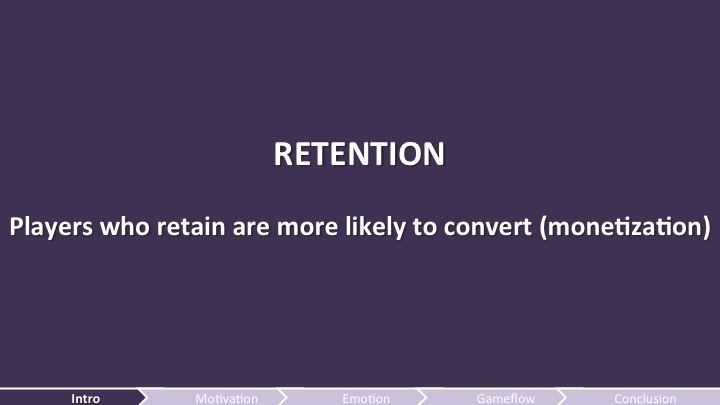
The main purpose of this talk today is to understand better the mechanisms of retention. And the reason why we care is that, for free-to-play games, to make money you need to first retain players. Paid-upfront games also care about retention because players who retain are more likely to convince their friends to buy the game as well.
Retention, at its core, means engagement.
Also, when you’re engaged in an activity, it’s more pleasurable, so not only it’s good business practice but it’s also good UX practice.
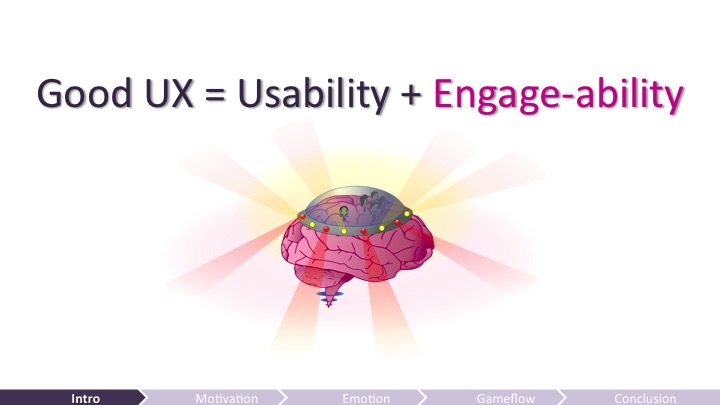
The part of UX that is more specifically relevant to retention is what I now call “engage-ability”. I used to call this part “gameflow” because it’s a familiar concept in game development.
However, it didn’t quite encompass all what’s important to engage players and retain them, this is why I’m now using that weird term. It may sound a bit pompous, but it has the advantage of expressing the ability of a game to be engaging, just like usability is the ability of the game to be used.
The variables behind usability and engage-ability are not working in silos. They interact with each other.
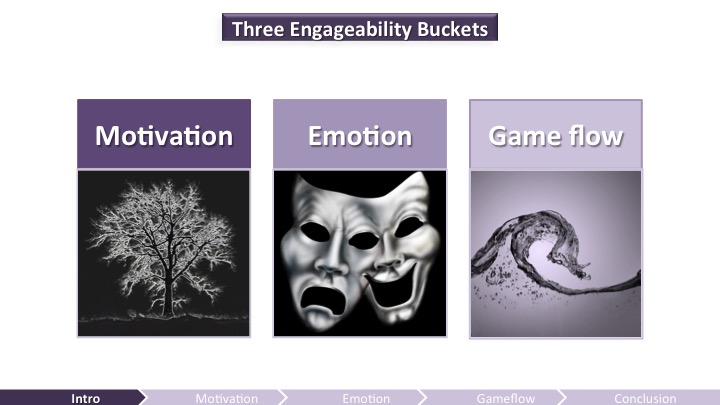
Here’s how I’m breaking down engage-ability: in these 3 pillars. Motivation, Emotion, and Game flow. Please note that this is *my* mapping of how to make games more engaging, based on academic research on one hand, and my own game development experience with various teams (at Ubisoft, LucasArts, and Epic Games) along my 10 years in this industry.
Motivation – Motivation is at the origin of all human behavior, and ultimately engagement is all about motivation. Emotion and game flow both contribute to motivation.
Emotion – Emotions serve motivation in the sense that they help us choose the right behavior (e.g. flee when we are scared).
Game flow – It’s a state of deep focus and immersion, which is a concept often used in games, and is also important for engagement.
Even though rewards and motivation are very popular topics at GDC, it’s rare to see these topics tackled having a bigger picture in mind. So this is what I want to do today: showing you the big picture, and I will dive more deeply into a few concepts, for each pillars, and more specifically regarding motivation.
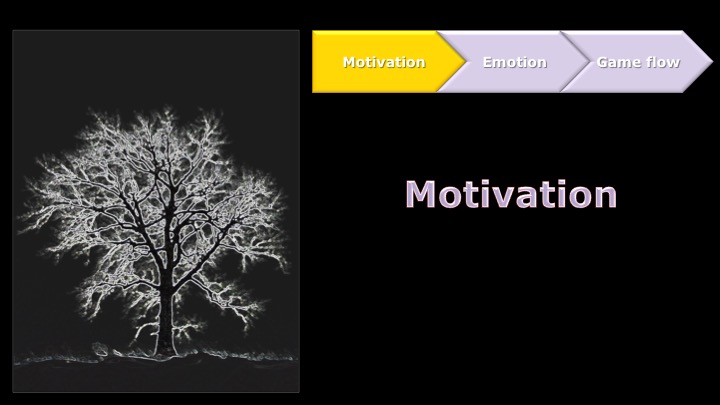
Motivation is a the origin of any behavior. Without motivation there is no action.
It is critical to the survival of organisms needing movement to survive, therefore is key to understand where human behavior come from, and by extension to understand what make players tick.
I’m using a tree here because we often talk about meaningful choices when referring to motivation, and games often have skill trees to offer meaningful choices to players.

Human motivation is super interesting but the problem is that they are a LOT of motivational theories in psychology. This is a screenshot from the Wikipedia page dedicated to motivational theories and it does not list all of them. Not even close.
You need to understand this about motivational theories: Countless theories have been proposed to explain human motivation but a solid meta-analysis is still missing to make sense of it all.
There is no current consensus, nor a unified theory of human motivation that can account for all our drives and behaviors in a clear mapping.
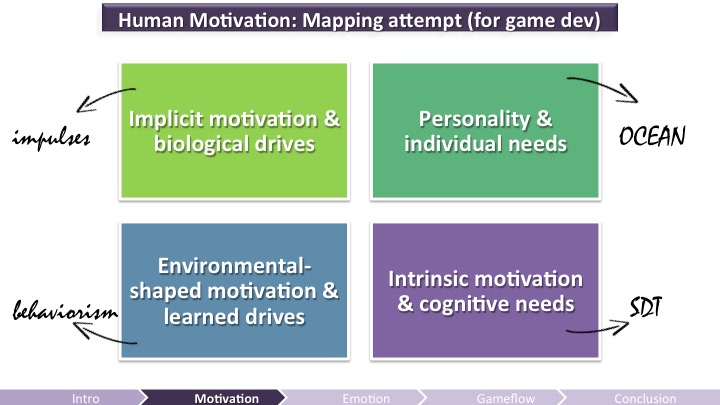
So here is what I propose: an Attempt to organize human motivation in a simple mapping (therefore inaccurate because science is complex) to help game development.
Disclaimer! These are not really separate buckets. They are not independent and not hierarchical. I’m going to very briefly introduce the top 2 but I’ll quickly move on to the 2 bottom ones for the sake of time, since these are particularly relevant for us.
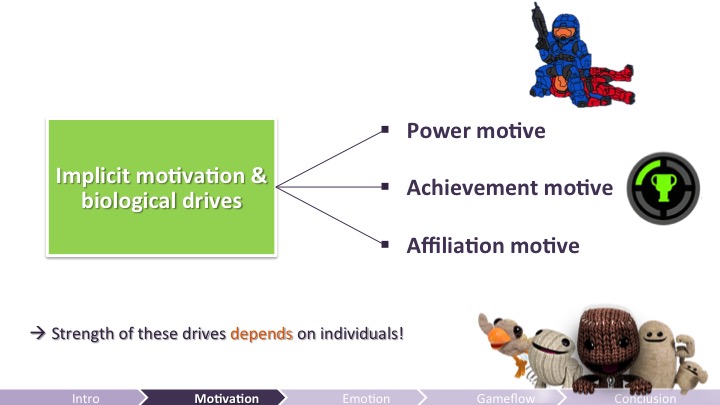
Biological drives are very basic needs that we share with other mammals. For example, hunger, thirst, need for sleep, pain avoidance, and sex are powerful innate physiological motives aimed to satisfy our biological drives.
Other implicit motives can also influence our social behavior (more relevant for us). Three of these implicit drives have been more particularly studied: the power motive, one’s motivation to dominate others, the achievement motive, one’s motivation to improve on a task, and the affiliation motive, one’s motivation for close and harmonious social relationships
Depending on how strong these drives are within individuals, they will influence the pleasure we feel from certain situations differently, which in turn will influence our behavior. So not everyone is super excited at the idea of dominating others, for example.
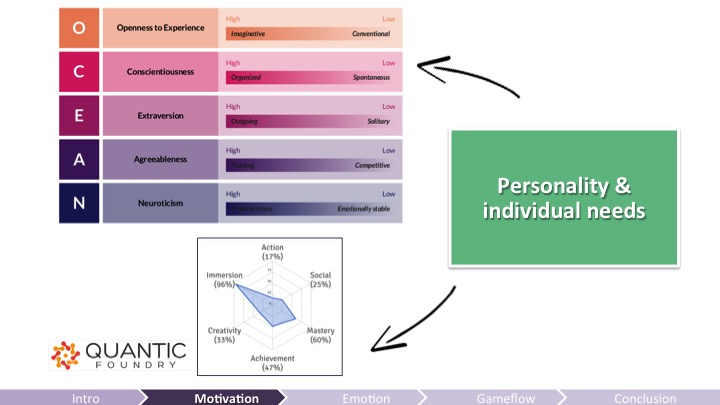
Moving on to the next bucket. Generally, when we talk about individual differences, we mainly think about personality models. OCEAN, or Big Five, is about personality differences, measured against 5 traits. For example, some people score high in Extraversion, meaning that they are more outgoing than people who score low on that trait.
OCEAN model has some limitations: it is NOT stable during your lifetime and it CANNOT accurately predict behavior. It also does not explain all of human personality, but it is the most robust model we currently have and it is certainly interesting to keep in mind to account for human motivation. For example, an individual who scores high in Openness might be more motivated to accomplish a creative task than a low scorer. Nick Yee for example, from Quantic Foundry, is using this model to account for gamers’ preferences.

Video games being a specific environment shaping players’ behavior, this learned-drives bucket is really important for us. And it’s mainly about rewards and punishments.
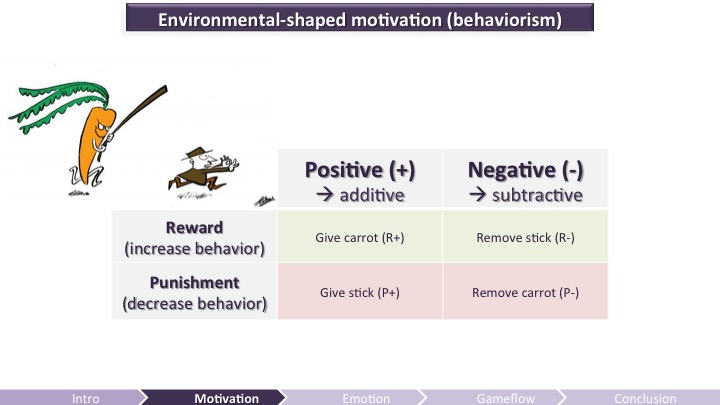
Response from the environment (the game) after player’s action can be either positive or negative. When positive, it means we’re adding something: player receives a carrot or is hit by a stick. When negative, it means we subtract something: a stick or a carrot is removed from players. Depending on how this feedback from the environment is perceived by players, player’s behavior will either increase (be repeated) or decrease (stop).
- Positive reward example: you kill an enemy, you get a reward.
- Negative reward example: you equip a shield, you don’t get one shot killed anymore, we remove the pain of dying.
- Positive punishment: you tower-dive in a MOBA, you die.
- Negative punishment: you commit toxic behavior, you get banned from the game (we remove the game from you). Or you did not manage to retrieve your souls, you lose them. By extension, a negative punishment could happen if you collect, say, 100 flags in Assassin’s Creed, and you don’t get any meaningful reward for it. Even though it’s not something removed from players technically, if an expected reward doesn’t come, it could be felt as a punishment.
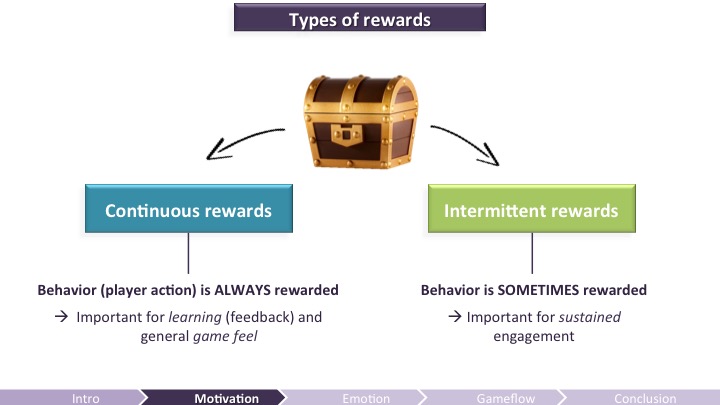
You have different types of rewards. Rewards can be given continuously or intermittently.
Continuous rewards is when player action is always rewarded (particularly important for learning and game feel).
Intermittent rewards is when player action is sometimes rewarded (particularly important for sustained engagement). Let’s dive deeper into this kind, since it’s very frequently used in games.

Rewards can be intermittent based on time (interval) or based on player action (ratio).
Both these reward types can be given expectedly (at a fixed interval or ratio) or unexpectedly (at an uncertain interval or ratio). Let’s see some examples of each in games.

In Fortnite you get a reward every day if you log in. In Clash of Clans, you get your reward after a set amount of time (once the building is built).
It’s good to use to lure players back in the game, but once they are here, you need to have something else for them (multiple fixed interval rewards, or new quests, or they are told friends are in a mission and player can join them).

Sometimes it’s a fixed interval before removing the reward.

You know the cherry bonus is going to appear at some point in Pacman, but you don’t know when. Same in MMOs when you know that a certain mob can spawn at a certain place but when is unpredictable.

Rewards for quests and abilities unlocked in skill trees are examples of fixed ratio: you need to do a certain number of actions to get the reward. Progression bars are kind of fixed ratio rewards: you know how much experience points you need to get to the next level, but the actions you do in the game usually give you an unexpected number of XP.
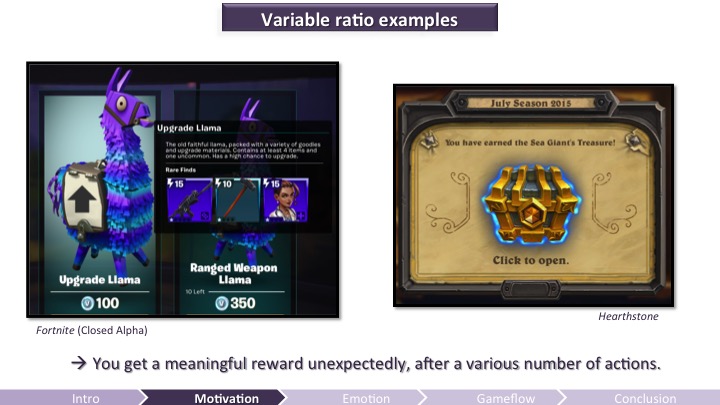
It’s gambling. Slot machines. You want something valuable to you, but you never know when you’re gonna get it. Other examples: loot crates, card packs, chests in world, etc.
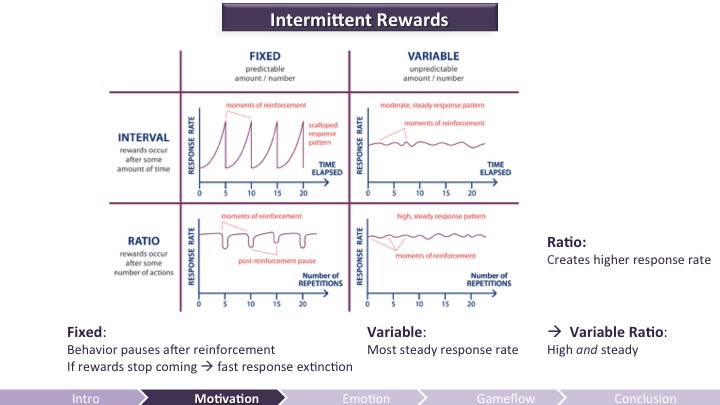
Here you can see the different impact on behavior (player action) each type of rewards has:
- Fixed: Behavior pauses after reinforcement (more actions to reward leads to longer pause).
- Extrinsic rewards can undermine intrinsic motivation -> if you were doing something for its own sake (say, drawing) but then I give you a reward to do it, if I remove the reward then you might be less intrinsically motivated to do the same than before there was a reward.
- Variable rewards overall lead to the most steady response rate.
- Rewards based on ratio (player action) creates higher response rate than if based on time.
- Highest and most steady response rate comes with variable ratio rewards.
As you can see, these different types of reward affect player behavior very differently.

So when researchers say that extrinsic rewards can deter intrinsic motivation, yes, but really in depends on many things: on the type of reward, and on the context (whether or not the person was intrinsically motivated to do a task without consideration or rewards to begin with, if the reward is money, verbal, or items, etc.).
Also, usually, you see a decrease in intrinsic motivation and behavior when a reward is introduced then removed. And it doesn’t happen that often in games. Travis Day from Blizzard mentioned it in his super interesting talk yesterday, when players reach max level in WoW for example, then it seems that rewards stop arriving since XP don’t matter anymore. But it’s not that rewards stop arriving as players do stuff in the game, it’s that players have reached an end goal and might not have another meaningful goal to work towards. Hence the importance of community events and new quests and new content. This is why rewards are highly related to goals, both must be meaningful to keep players engaged, and a reward must not be an end goal, but a means for the next goal.
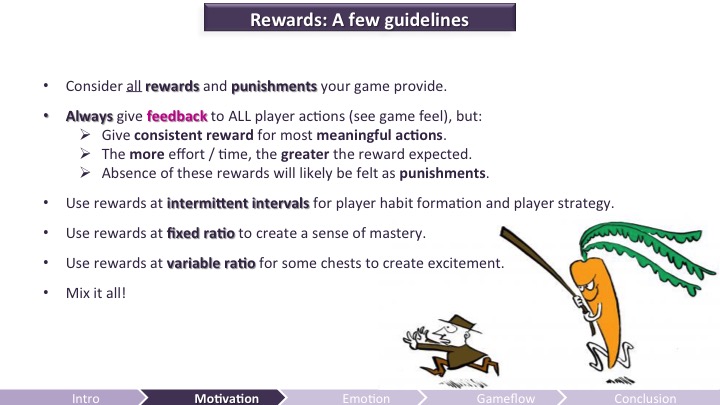
These are not mutually exclusive and these are broad guidelines. In practice, like I said, there are a lot of subtleties depending on the context.

Intrinsic motivation is when you do an activity for its own sake.
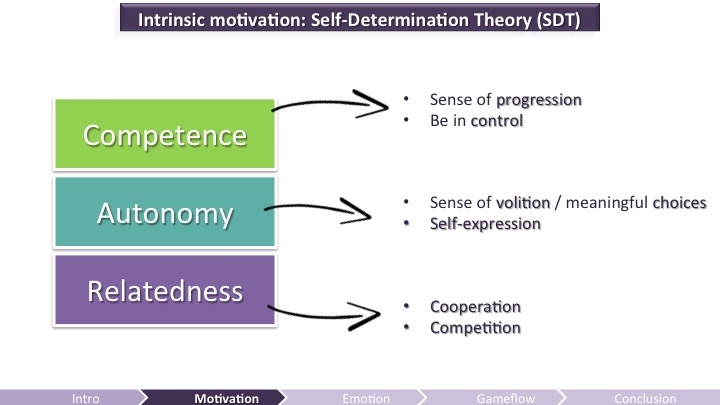
I’m not going to describe Self-Determination Theory (SDT) in detail, because tons of GDC talks discuss this every year. In a nutshell, it’s about the need for:
- Competence: sense of progression, sense of being in control.
- Autonomy: sense of volition, having meaningful choices, being express to express yourself.
- Relatedness: sense of meaningful social relationships, either through cooperation or competition.

The undermining effect of extrinsic rewards can take place when they thwart one or more of these 3 needs.
This is why for example we give the illusion of control to gamblers, so they can feel a sense of autonomy even though the outcome is ultimately completely random.

SDT is currently the most popular theory of intrinsic motivation, however it cannot account for all human behavior. You have to take behaviorism and individual needs and drives into account.
Some Self-Determination theorists moved away from the intrinsic/extrinsic motivation dichotomy and instead focus on the distinction between autonomous and controlled motivation (with different types of rewards).
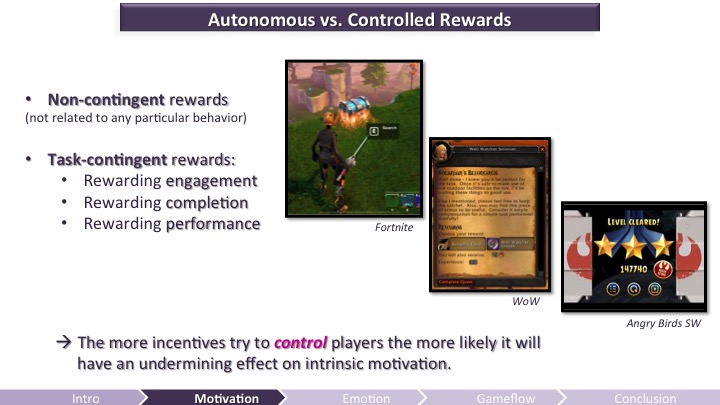
You have non-contingent rewards, not related to any particular behavior from the player (surprise gift just because!). You also have Task-contingent rewards, which reward engagement (you find a chest as you engage in a Fortnite quest), completion (you get a reward in WoW after completing a mission), or performance (the number of stars you get in Angry Birds depends on your performance).
Performance-contingent rewards that are given specifically for matching some standard of excellence are likely to be experienced as the most controlling. However, since they can also act as a feedback on competence and give a powerful sense of mastery, the negative effect of the control can be counteracted by the expression of a sense of progression (when there is such progression). Rewards that are task-contingent but given simply for completing a task might be felt as less controlling but they also do not offer any perceived increase of competence and could therefore ultimately be the worst kind of all as far as intrinsic motivation is concerned.
Just another illustration that it’s all quite complicated and not easily predictable.

Travis Day also mentioned yesterday that making players swim in rewards, being generous with them, increase engagement. Which I totally agree with, but ONLY IF these rewards have a meaningful value for players. Let’s take an example from Paragon, after the first match against bots you play. In the video, you could see rewards flowing in. The intent was to feel rewarding but players dismissed them. It could actually be perceived as punishing if it’s overwhelming. It could actually make players feel anxiety as they realize they need to learn about all of these rewards they have no idea what they are for.
Also, players do not really understand the value of the rewards at that point. Show the lock, the purpose, the goal, before giving the key, the rewards, which are means to an end.
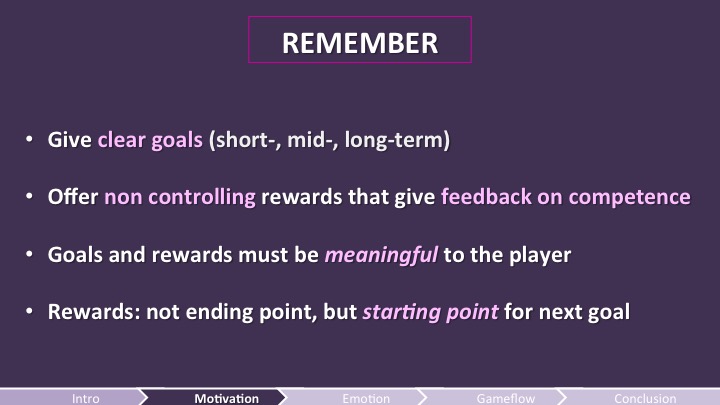
Key takeaway regarding motivation and rewards overall. Goals and rewards must be meaningful to the player.
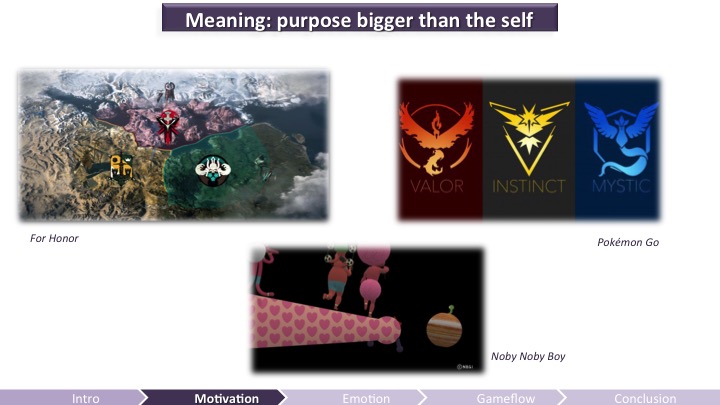
Meaning can also be a sense of purpose greater than the self. And this is why being part of guilds or factions is highly meaningful.
For example, in For Honor you have a faction war persistent cross-platform conflict between kights, vikings, and samurai. In Pokémon Go, you choose to root for team Valor, Instinct, or Mystic.
Noby Noby Boy: In the game, the player controls the character Boy, who can stretch his body. The player accumulates points by how much they stretch during gameplay. These points can be submitted online grow Girl. Points submitted online by players to Girl will be added cumulatively across all players, causing Girl to stretch into the milky way. It took for example 7 years to Noby players to make Girl reach Pluto together.

You need to consider motivation as a whole, with all its complexity to maybe be able to anticipate your players’ behavior and projected engagement.
So please, if you hear simplistic one-fits-all solution about motivation, be dubious. Yes, it might sound seducing to get a magic pill to solve all of your problems, but ultimately it could mislead you if you don’t consider all the complexities of human motivation.

Emotion serves motivation. When detecting a danger, you feel emotion (fear) to get you to run away.
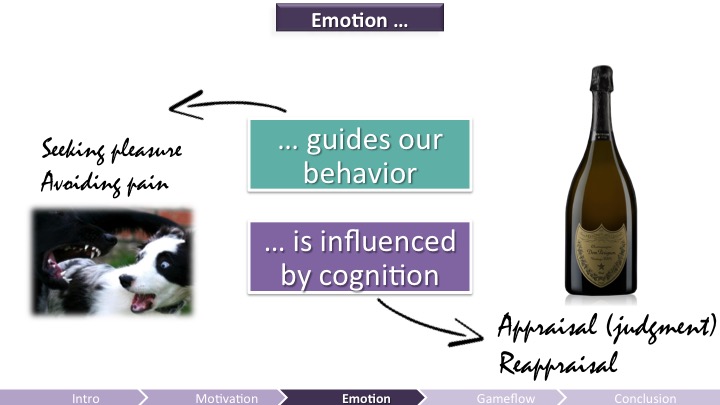
Emotions are critical to learning and survival because they guide us through our interactions with the environment, as we seek pleasure and avoid pain.
But emotion is also influenced by cognition; top-down processes involving prior knowledge, expectation, and judgment (appraisal) of a situation. That’s why presentation is important: if something looks good (like this nice bottle of champagne), you will likely experience more pleasure from drinking it. Similarly, if you experience something frustrating in the game, such as losing a PvP match, you might attribute your frustration to the gameplay itself, not simply the match outcome.
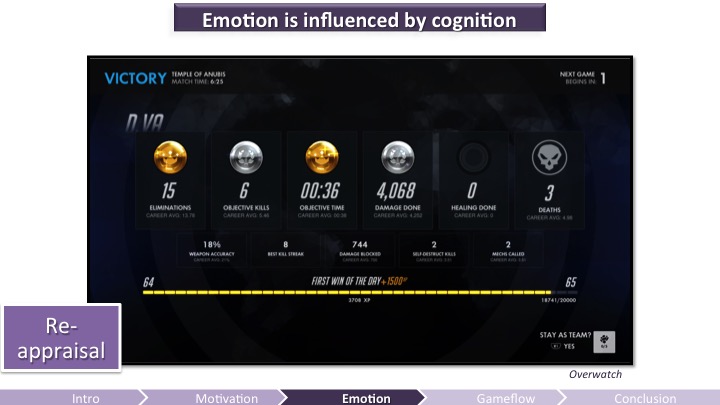
Since appraisal can modify how we feel about a situation, helping players to reappraise their negative feelings might have some benefits. For example, instead of letting them feel bad as they see in big red letters that their team has lost and they suck, you could emphasize instead what they did better than the winning team, or that despite losing they have improved on some personal metrics. Overwatch is particularly good at that, pointing out at the end of the match when players’ beat their “career average”, and it can be about many different metrics, such as number of kills (eliminations), time stayed on the objective area, healing done, weapon accuracy, etc.
Use cognitive reappraisal to regulate negative emotions that can be tied to losing.
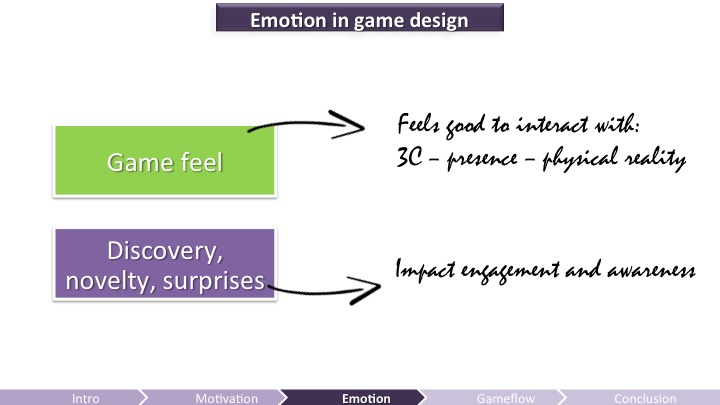
In game design, we usually talk about Game Feel when mentioning motivation. For example, 3C’s (controls, camera, character). Controls are particularly important, because if players don’t experience real-time control, they will likely feel controlled by the game, which will negatively impact their sense of autonomy, important for intrinsic motivation
Presence is experienced when players have the illusion that nothing is between them and the virtual world, when they perceive that they are simply in the game with no mediation.
Discovery, surprises, are also very important as they impact players’ level of engagement and awareness.
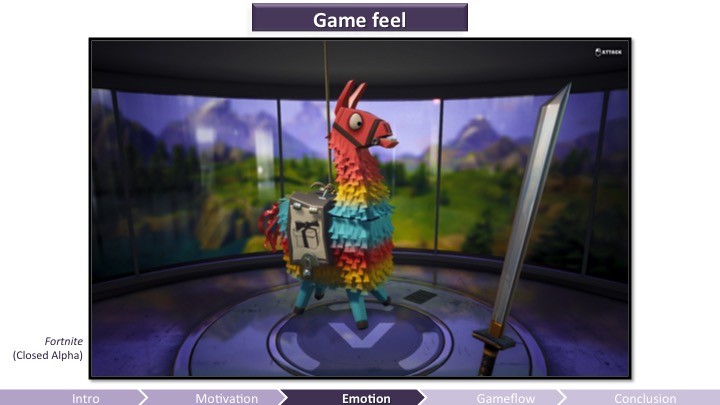
Importance of art direction, animation, music, sound effects, etc. In Fortnite, it feels really good to open card packs: they are piñatas that you hit with a melee weapon, and the llama reacts to your actions.
Just like the lever in slot machines, give the illusion of control to open a pack, chest, loot, etc.
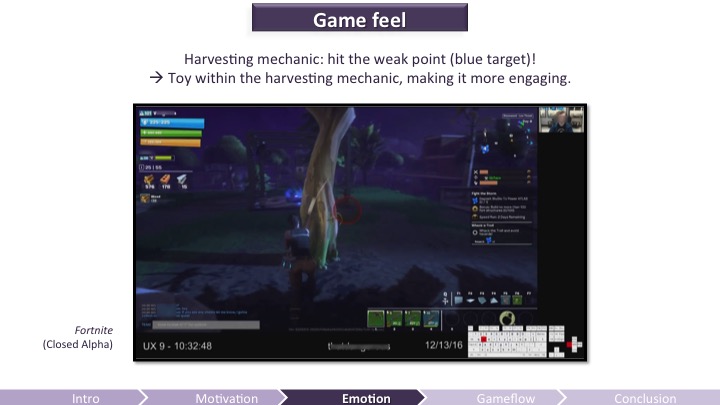
When hitting weak point in Fortnite, you harvest the item faster and you hear a nice rewarding sound effect that goes up in tone each time.
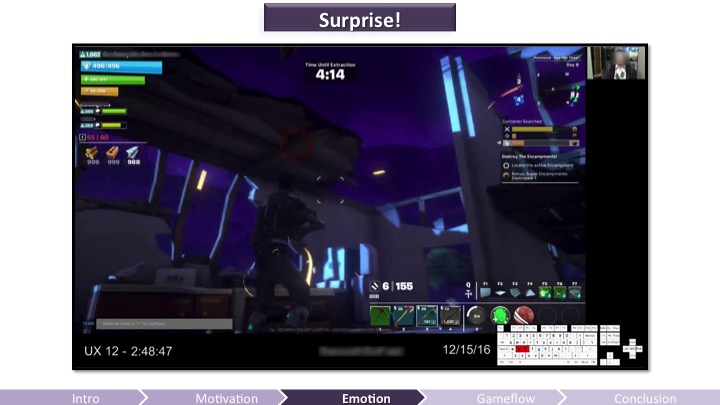
Surprise the player by doing unexpected things. For example, in Fortnite players can open chests in the world, but at some point some chests can hide zombies!

Think about how emotions can meaningfully support your game.
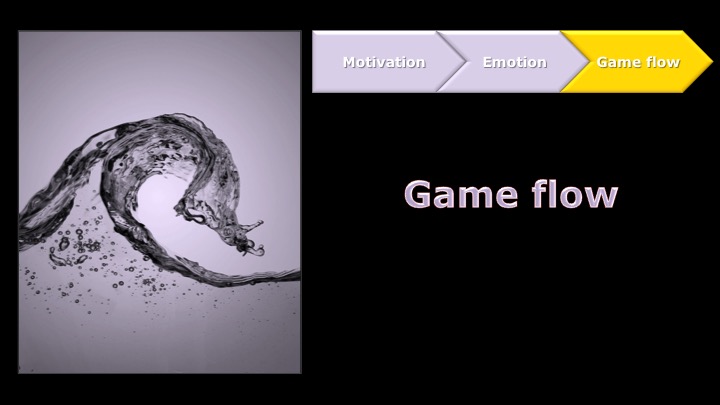
Let’s quickly discuss about how to put the player in the zone.

I’m not going to describe this in detail, because you should know this pretty well already, but game flow is about difficulty curve, pacing, and learning curve.
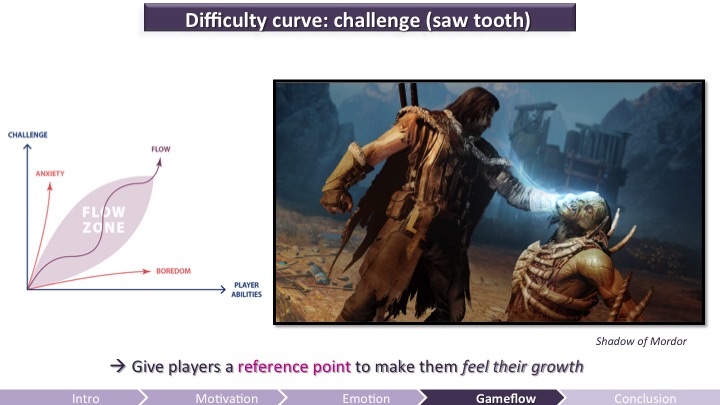
One thing I want to emphasize here: You can’t have a straight line in the flow zone because if the challenge increases at the same pace as player’s abilities do, they the perceived challenge is always the same. You never feel extra challenged nor extra competent.
So you need to approach game flow like a wave. You need a saw tooth difficulty progression and to create situations where an old ability can be compared to new ability (it makes the player realize the progress made, makes players feel competent, which is important for motivation).
In Shadow of Mordor you can kill Uruks captains who killed you earlier. You can track them. It feels very satisfying to finally kill them; you really feel your progress.
Give players a reference point to make them feel their growth, it’s very important.

People are less efficient in stressful situations (impacts feel of competence). A little stress can help focus, too much stress affects memory. Keep the right balance depending on the complexity of the task and level of expertise
Example: the very first thing you do in Fortnite is killing a bunch of enemies. This is how we teach about shooting: in a meaningful situation (adds a little stress to focus). BUT the enemies are behind a low wall, so they cannot get at you (still safe, even if you panic you have time to calm down and shoot them all).
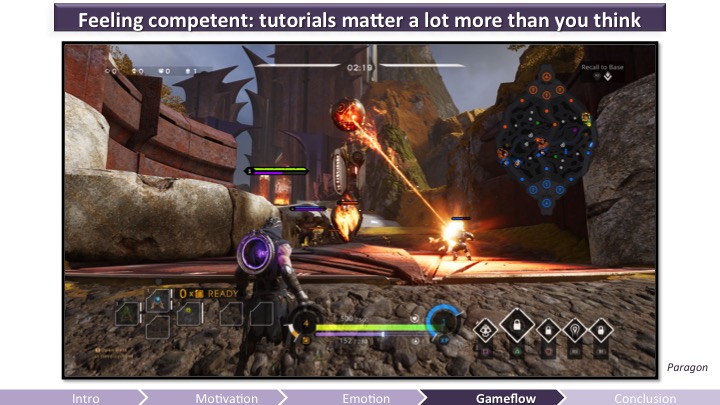
Regarding learning curve and onboarding: being competent in the game has a direct impact on retention. Analytics in Paragon showed that the most impactful factors for churn were related to lack of competence: dying from towers and not equipping cards. Turns out players didn’t really understand the subtleties of tower aggro and cards.

For example, we would see in playtests a lot of core players tower dive. Many did not understand perfectly the tower aggro rules (let minions get the aggro first, don’t target an enemy within tower range, etc.). After we added a tutorial level to explain some of these rules, retention got a bit better.
Fun fact: even though adding the tutorial level helped retention, we would still see some players tower dive in playtests, less but still. So adding a tutorial once is not necessarily enough.
Efficiently teaching your game to players is paramount, because players need to feel competent to stay engaged, especially in a multiplayer game.

Difficulty curve, pacing, and learning curve all impact player’s perception of being competent, therefore is critical to motivation.
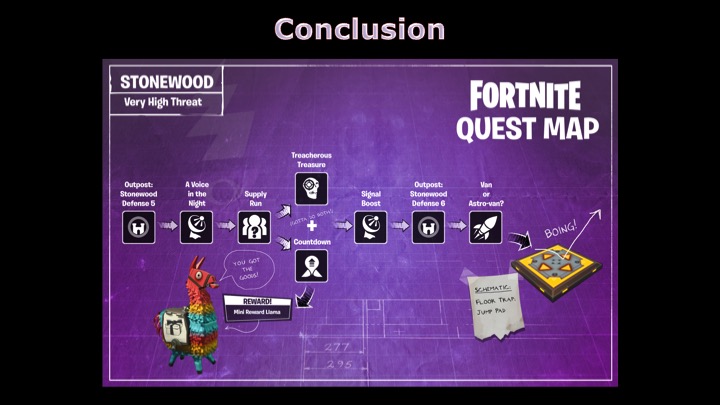
Let’s wrap this up!

- Retention (engage-ability) is about motivation, which entails managing goals (e.g. quests, events) and rewards, but not only.
- Motivation has a lot to do with moment-to-moment emotions: game feel & surprises.
- And it’s mostly about feeling competent and a sense of growing mastery: game flow, especially onboarding, is paramount.
- Usability has a critical impact on all of the above, because it impacts the level of frictions and the sense of being in control. If you have too many usability issues, it’s likely that players won’t feel any sense of mastery. If players don’t understand the value of certain rewards, if they don’t see that they are getting a reward, or that they have a new goal, it certainly won’t help motivation. So please do not neglect usability. It’s critical to engagement too.
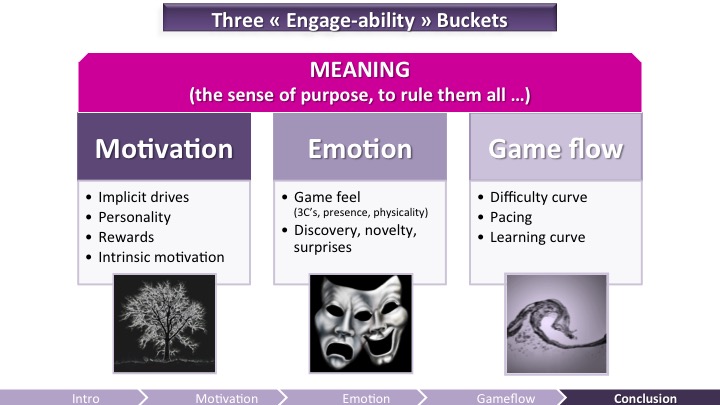
The commonality here is that you always have to think about what is the meaning for players, why they would care about the goals you set for them and the rewards you give them.
Let me take one last example to illustrate this.
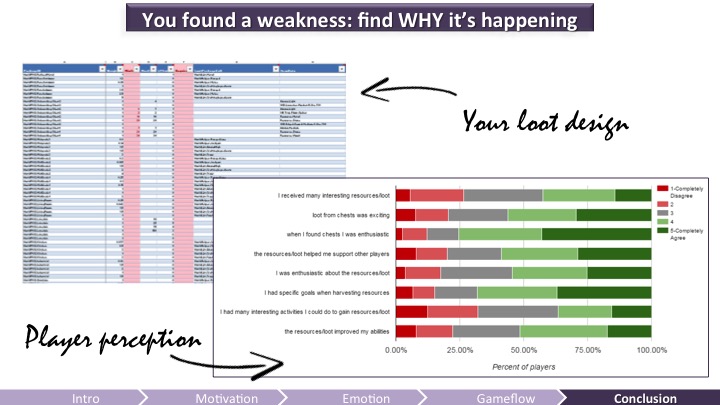
When you identify an issue in your game, when your design is not experienced the way you want by players, you need to ask yourself why is this going on. There are 3 main possibilities:
- Something missing in the design (one critical system has not been implemented yet).
- It’s all here but not balanced well.
- Systems are all in and well-balanced but they are not conveyed properly to the players.
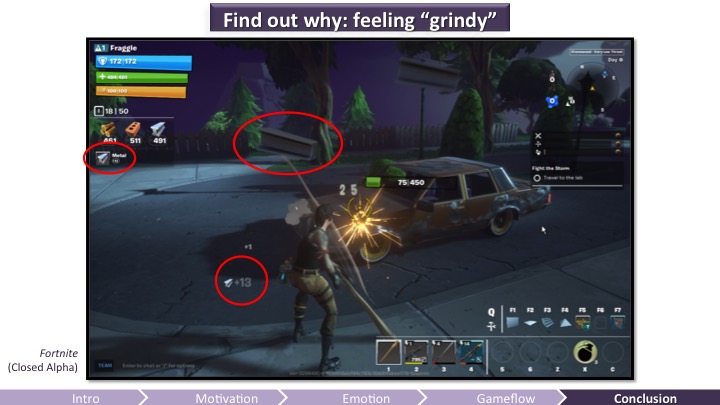
Let’s take an example from Fortnite: players often said in surveys that they felt the game to be too “grindy”. So, there’s one big obvious problem we had so far: the systems were not all here (missing the expedition system that can alleviate that feeling).
But, there’s also something on in the feedback when harvesting that can make players not understand what they clearly get from each hit (it seems that they get only one item per hit, which is not the case).
So here we actually have a usability problem impact the perception of how much you actually get from harvesting (it feels less than the reality).
But we also had for a long time a problem with the weak points.

Remember that players can harvest faster in Fortnite when they hit weak points? Well, it took us quite some time to get players to understand this mechanic.
- First, the sign for the weak point was yellow, players would ignore it. So I thought it was a usability problem.
- The team therefore changed the weak point sign into something more visible. Players would still ignore it. They thought it was telling them they were targeting this particular item.
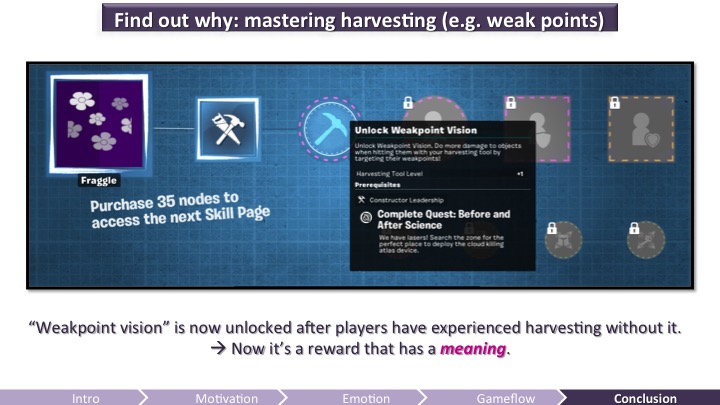
In the end, the development team made the weak point mechanic an ability players can unlock in the skill tree, after having experienced the harvesting mechanic first.
Therefore, it gave the weak point purpose, players understood why it was meaningful, because they already had a reference point of how long harvesting can take, therefore immediately understood the value of this feature. And this is how most players are now using the weak point feature.
There’s always a ton of solutions you can come up with when you see a player behavior that is not intended, but the real challenge is to find the real problem to address. If you don’t have an overall understanding of the UX ingredients, it may be hard to identify what the problems really come from.
So have a clear overall mapping of player engagement, know the ingredients, and make hypotheses which you can test as you develop your game to identify the real issues and fix them appropriately.
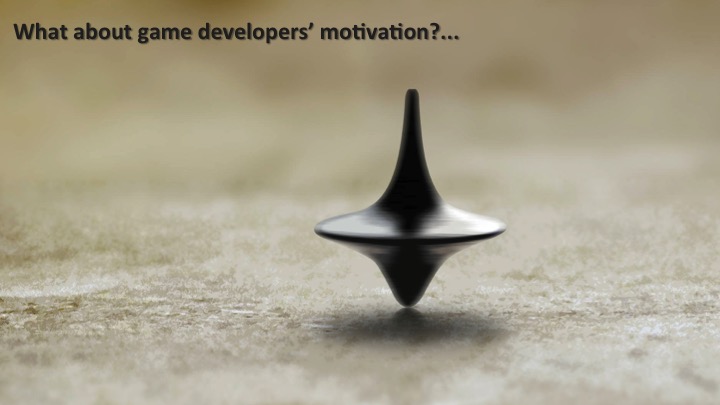
We always talk about players’ motivation but… what about game developers’ motivation?…
Intrinsic motivation is important for creativity. Guess what happens when you are given a motivation “recipe” to follow:
- Games end up being all the same and too predictable (hinders the potential for surprises).
- Developers feel less volition creating the game, therefore don’t put their heart and soul in it.
Even if there was a secret sauce or a perfect recipe (there isn’t), game development is mostly a creative endeavor so developers need to find their own recipe to be motivated and ship quality.
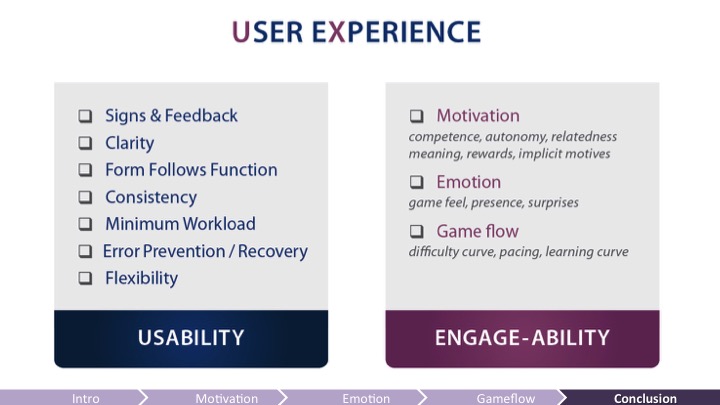
As UX practitioners, we are only here to offer guidance.
We can provide game developers with a methodology (user research), and guidelines such as these UX pillars; the ingredients that are important to offering a great user experience.
But in the end it’s up to you to make your own recipe.


Pingback: GDC 2017 Presentations | Krzysztof Narkowicz